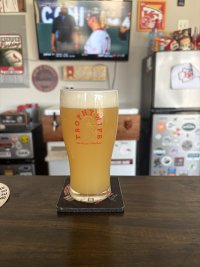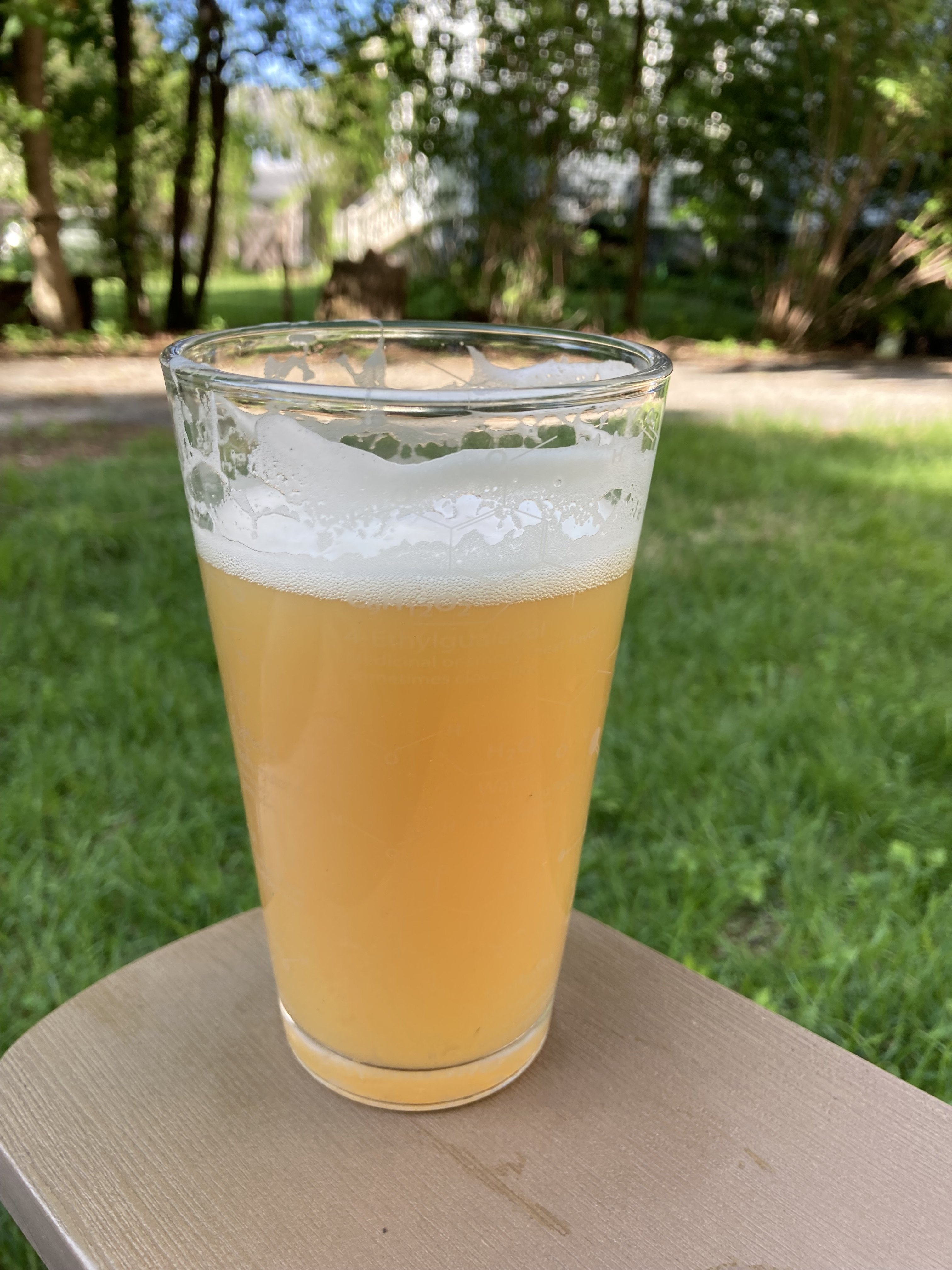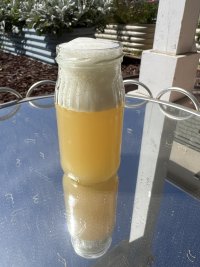You are using an out of date browser. It may not display this or other websites correctly.
You should upgrade or use an alternative browser.
You should upgrade or use an alternative browser.
New England IPA "Northeast" style IPA
- Thread starter Braufessor
- Start date

Help Support Homebrew Talk:
This site may earn a commission from merchant affiliate
links, including eBay, Amazon, and others.
synonymous18
Active Member
- Joined
- Jun 13, 2017
- Messages
- 29
- Reaction score
- 1
I have a hazy pale ale fermenting with a bit of warrior at 60 and citra at 10, WP. Want to do citra/Nelson and something else in the DH. Rakau? Riwaka? Other? Appreciate input.
I'd say riwaka... but my wife doesn't like riwaka (I know wth right?) So I don't brew with it.I have a hazy pale ale fermenting with a bit of warrior at 60 and citra at 10, WP. Want to do citra/Nelson and something else in the DH. Rakau? Riwaka? Other? Appreciate input.
Mtozbun
Well-Known Member
Just did a very similar hazy pale ale, but with Rakua/Nelson WP and Citra/Rakua/Nelson in the DH at 1.5:1:1 ratio. Highly recommend this combo.I have a hazy pale ale fermenting with a bit of warrior at 60 and citra at 10, WP. Want to do citra/Nelson and something else in the DH. Rakau? Riwaka? Other? Appreciate input.
Attachments
stickyfinger
Well-Known Member
stickyfinger
Well-Known Member
Interesting. Lupomax quality was higher? I haven’t used that for awhile. Consistency would be niceMy last couple I've dry hopped in the serving keg, but I've used Lupomax and I've noticed a huge difference with those hops vs traditional.

$76.92 ($2,179.04 / Ounce)
Brewing accessories 1.5" Tri Clamp to Ball Lock Post Liquid Gas Homebrew Kegging Fermentation Parts Brewer Hardware SUS304 Brewing accessories(Gas Hose Barb)
chuhanhandianzishangwu

$53.24
1pc Hose Barb/MFL 1.5" Tri Clamp to Ball Lock Post Liquid Gas Homebrew Kegging Fermentation Parts Brewer Hardware SUS304(Liquid Hose Barb)
yunchengshiyanhuqucuichendianzishangwuyouxiangongsi

$10.99 ($31.16 / Ounce)
Hornindal Kveik Yeast for Homebrewing - Mead, Cider, Wine, Beer - 10g Packet - Saccharomyces Cerevisiae - Sold by Shadowhive.com
Shadowhive

$44.99
$49.95
Craft A Brew - Mead Making Kit – Reusable Make Your Own Mead Kit – Yields 1 Gallon of Mead
Craft a Brew

$479.00
$559.00
EdgeStar KC1000SS Craft Brew Kegerator for 1/6 Barrel and Cornelius Kegs
Amazon.com

$53.24
1pc Hose Barb/MFL 1.5" Tri Clamp to Ball Lock Post Liquid Gas Homebrew Kegging Fermentation Parts Brewer Hardware SUS304(Gas MFL)
Guangshui Weilu You Trading Co., Ltd

$22.00 ($623.23 / Ounce)
AMZLMPKNTW Ball Lock Sample Faucet 30cm Reinforced Silicone Hose Secondary Fermentation Homebrew Kegging joyful
无为中南商贸有限公司

$33.99 ($17.00 / Count)
$41.99 ($21.00 / Count)
2 Pack 1 Gallon Large Fermentation Jars with 3 Airlocks and 2 SCREW Lids(100% Airtight Heavy Duty Lid w Silicone) - Wide Mouth Glass Jars w Scale Mark - Pickle Jars for Sauerkraut, Sourdough Starter
Qianfenie Direct

$58.16
HUIZHUGS Brewing Equipment Keg Ball Lock Faucet 30cm Reinforced Silicone Hose Secondary Fermentation Homebrew Kegging Brewing Equipment
xiangshuizhenzhanglingfengshop

$159.99 ($26.66 / Count)
3M High Flow Series System BREW120-MS, 5616001, For Brewed Coffee and Hot Tea, Valve-in-Head Design
SpaceCityProviders
![Craft A Brew - Safale S-04 Dry Yeast - Fermentis - English Ale Dry Yeast - For English and American Ales and Hard Apple Ciders - Ingredients for Home Brewing - Beer Making Supplies - [1 Pack]](https://m.media-amazon.com/images/I/41fVGNh6JfL._SL500_.jpg)
$6.95 ($17.38 / Ounce)
$7.47 ($18.68 / Ounce)
Craft A Brew - Safale S-04 Dry Yeast - Fermentis - English Ale Dry Yeast - For English and American Ales and Hard Apple Ciders - Ingredients for Home Brewing - Beer Making Supplies - [1 Pack]
Hobby Homebrew

$7.79 ($7.79 / Count)
Craft A Brew - LalBrew Voss™ - Kveik Ale Yeast - For Craft Lagers - Ingredients for Home Brewing - Beer Making Supplies - (1 Pack)
Craft a Brew

$20.94
$29.99
The Brew Your Own Big Book of Clone Recipes: Featuring 300 Homebrew Recipes from Your Favorite Breweries
Amazon.com

$176.97
1pc Commercial Keg Manifold 2" Tri Clamp,Ball Lock Tapping Head,Pressure Gauge/Adjustable PRV for Kegging,Fermentation Control
hanhanbaihuoxiaoshoudian

$28.98
Five Star - 6022b_ - Star San - 32 Ounce - High Foaming Sanitizer
Great Fermentations of Indiana

$719.00
$799.00
EdgeStar KC2000TWIN Full Size Dual Tap Kegerator & Draft Beer Dispenser - Black
Amazon.com
InspectorJon
Well-Known Member
Happy 20,000thI recently brewed a 1.077 neipa. I fermented in a Speidel fermenter and purged two kegs, dry hop and serving kegs, with fermentation gas. It's carbing up now.
Looks great. What was your hop schedule and what does it taste like? I just used a scant 2 oz of Idaho 7 lupomax in the whirlpool of my mostly Mosaic NEIPA, and its still pretty harsh and earthy after a good amount of time in the keg.Love me some Idaho 7 IPA! Never fails! Thanks to @Dgallo for recommending oat malt and wheat malt combo. I did 20% of each with the rest Rahr Pale and it’s a rich flavor without being too malty View attachment 875240
stickyfinger
Well-Known Member
I used about 1 oz/gal Eureka in the hop stand and then dry hop was 16 oz at 54F after dropping yeast.Looks great. What was your hop schedule and what does it taste like? I just used a scant 2 oz of Idaho 7 lupomax in the whirlpool of my mostly Mosaic NEIPA, and its still pretty harsh and earthy after a good amount of time in the keg.
16 oz Idaho 7 in the DH?I used about 1 oz/gal Eureka in the hop stand and then dry hop was 16 oz at 54F after dropping yeast.
stickyfinger
Well-Known Member
Yeah!
Latest homebrew.
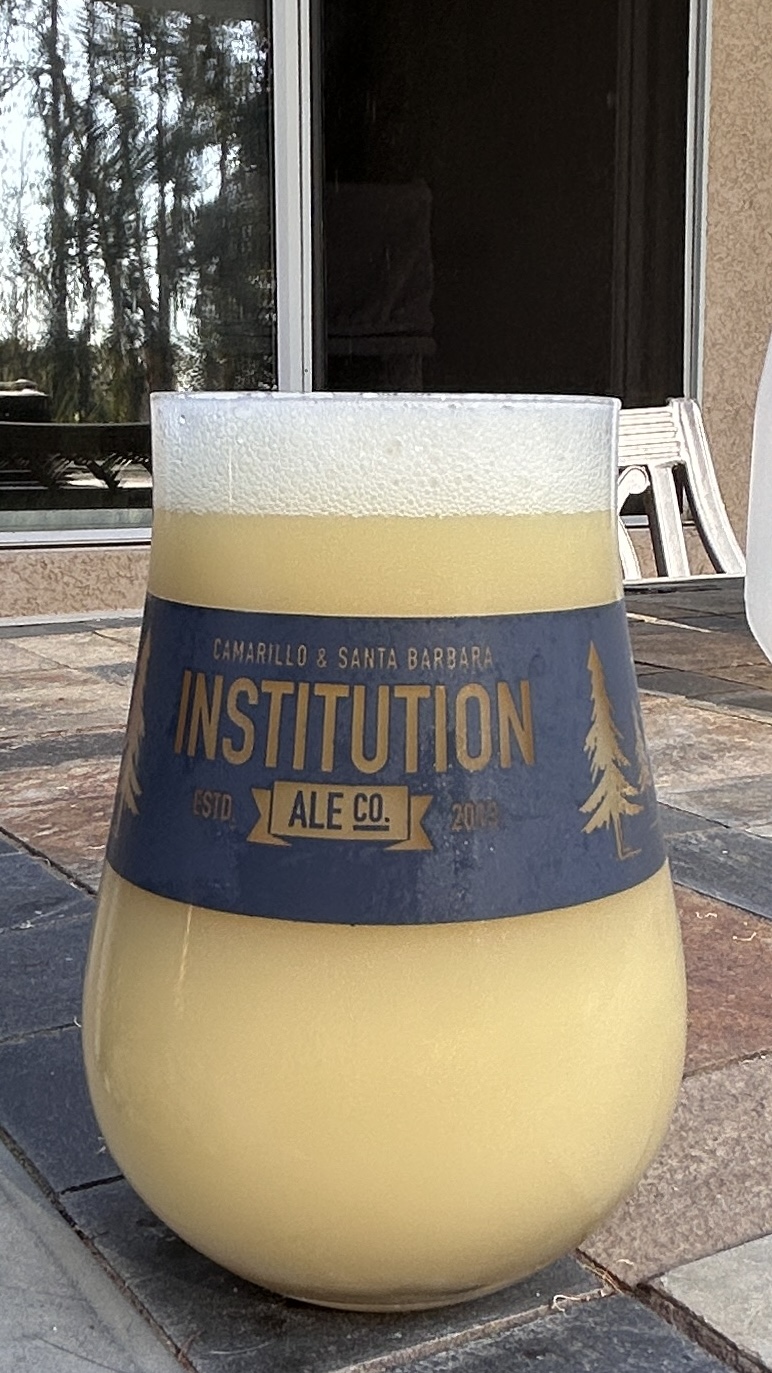

Wow, this just keeps getting better.
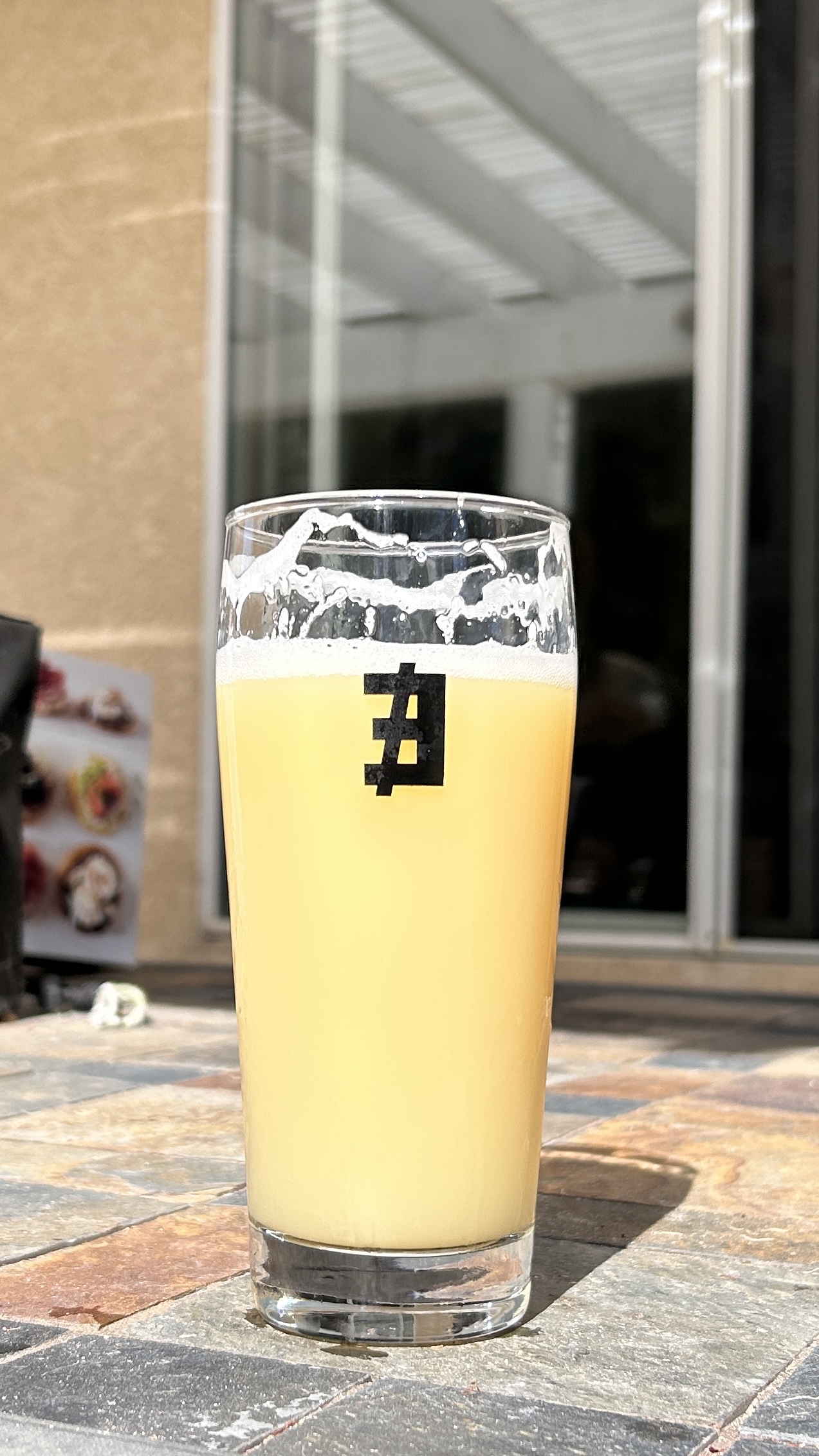

fluketamer
Well-Known Member
- Joined
- Dec 1, 2008
- Messages
- 1,952
- Reaction score
- 2,560
holy hops batman !Yeah!
stickyfinger
Well-Known Member
yeah, i'm doin 6ish gallons in primary and add a pound of dry hops when i'm doing higher abv beers with LAIII type strains.That’s pretty standard dryhop. A lot of folks dryhop at 3oz/gallon. So this is most likely under that if he is accounting for dryhop loss, and has 6 gallons in the fb
Wondering this myself. I found several good ones on a trip last year to New Zealand. I tend to order them or pick up a 4-pack when I see them in the US, but they are often lack luster. I think the alcohol of a 7% to 8% beer helps out a lot with sweetness and extracting hops oils/flavors. I have played around a little with the style (with my best example not being crazy hoppy using Voss) but have been wanting to focus a bit more.Anyone have success with making a hazy pale ale? I’ve heard about them turning out well from some notable breweries but the few I’ve had have not been memorable. Anyone make something g great in the 5% range?
Shenanigans
Well-Known Member
Hi Guys,
I have some Falconer's Flight hops and 1272 American Ale II yeast.
So I plan on brewing an old clone recipe of Bissell Bros. Substance NEIPA.
Apparently the 1272 is good for biotransformation so I was wondering what the best dry hop process would be.
Recently best practice seems to be ferment to the end and soft crash to remove the yeast before adding the dry hop to amoung other things avoid hop creep and hop burn.
Would I be better in this case to dry hop at fermentation temp at the end of fermentation to promote the biotransformation?
Should I not worry too much about hop creep/burn as the DH is only 1oz per gallon and not 3oz and just go old school for an old school beer?
Any other advice?
Thanks!
I have some Falconer's Flight hops and 1272 American Ale II yeast.
So I plan on brewing an old clone recipe of Bissell Bros. Substance NEIPA.
Apparently the 1272 is good for biotransformation so I was wondering what the best dry hop process would be.
Recently best practice seems to be ferment to the end and soft crash to remove the yeast before adding the dry hop to amoung other things avoid hop creep and hop burn.
Would I be better in this case to dry hop at fermentation temp at the end of fermentation to promote the biotransformation?
Should I not worry too much about hop creep/burn as the DH is only 1oz per gallon and not 3oz and just go old school for an old school beer?
Any other advice?
Thanks!
TwitchellBrew
Active Member
I’ve used 1272 a bit. It’s a really nice yeast. If my lhbs carried it, I’d use it a lot more (i live in Florida so I don’t order liquid online). What’s your plan for whirlpool? That’s where you want to get your biotransformation from. And if only dry hopping at 1 oz per gallon you will definitely want some WP hops to beef it up. For the DH I think most of us will recommend a soft crash and drop hop in the 50s for about 48 hours. You probably wouldn’t get a lot of hop burn dry hopping early with falcon at that rate but you may get some hop creep, and I just don’t like the profile of dry hopping early as much.Hi Guys,
I have some Falconer's Flight hops and 1272 American Ale II yeast.
So I plan on brewing an old clone recipe of Bissell Bros. Substance NEIPA.
Apparently the 1272 is good for biotransformation so I was wondering what the best dry hop process would be.
Recently best practice seems to be ferment to the end and soft crash to remove the yeast before adding the dry hop to amoung other things avoid hop creep and hop burn.
Would I be better in this case to dry hop at fermentation temp at the end of fermentation to promote the biotransformation?
Should I not worry too much about hop creep/burn as the DH is only 1oz per gallon and not 3oz and just go old school for an old school beer?
Any other advice?
Thanks!
beervoid
Hophead & Pellet Rubber
I've been experimenting for a while, you'll never really get that hop saturated flavor as with a DIPA but I think that is also kind of missing the point of the Pale Ale which should be a more easy drinking style.Anyone have success with making a hazy pale ale? I’ve heard about them turning out well from some notable breweries but the few I’ve had have not been memorable. Anyone make something g great in the 5% range?
Whats a good route to go: 1) super big body, mash really high, maybe malto dextrin, finish at 1.020 and then still DH big. Or 2) more drinkable, sessionable, lighter hops presence more about balance.
Malt miller/verdant have a great write up for sundialer that’s nice but never tried that beer. I’m leaning more towards the bigger body one like I’ve heard Brujos and fidens describe.
Any opinions about how to hazy pale ale?
Edit: just remembered couchsending’s brewery!
So far I think using a bit more specialty malts, munich crystal etc, and mashing higher will def work to be able to support a substantial dryhop.
But it's a fine balance to not get the specialty malts clash with the hop flavor. Also ime dryhopping in lower amounts but higher temps to counter less abv for extraction helps to get most out of a lower dryhop. Simply adding more will easily overpower the delicate style a Pale Ale is.
Shenanigans
Well-Known Member
I’ve used 1272 a bit. It’s a really nice yeast. If my lhbs carried it, I’d use it a lot more (i live in Florida so I don’t order liquid online). What’s your plan for whirlpool? That’s where you want to get your biotransformation from. And if only dry hopping at 1 oz per gallon you will definitely want some WP hops to beef it up. For the DH I think most of us will recommend a soft crash and drop hop in the 50s for about 48 hours. You probably wouldn’t get a lot of hop burn dry hopping early with falcon at that rate but you may get some hop creep, and I just don’t like the profile of dry hopping early as much.
Great thanks for the feedback, for some reason I thought most of the biotransformation (BT) came from the dry hop hops.
However, I just read a bit about it now and it's a complicated subject with many different opinions, but it does appear that whirlpool hops are indeed expected to contribute more to BT than the dry hops.
BTW the recipe I was going to brew is a real old school NEIPA from 2013/2014 that is way different than today's versions.
https://www.brewersfriend.com/homebrew/recipe/view/293287/the-substance-clone-bissell-brothers-
I think I will now just use it as an inspiration and take the best of both worlds.
I'll change the 5 min additions to a 20 min whirlpool at 70 to 80oC and use double the amount of hops.
Also dry hop with 1.5 to 2 oz/gallon after fermentation is finished and softcrashing.
All my summit will be used up in the mash & whilrpool so I'll have to sub with something else or just increase the amount of the others
With all that sugar in the boil it will probably finish dryer than some people like for the style but that's fine with me as it makes it easier to drink.
Last edited:
LumberZach
Well-Known Member
Has anyone used 2024 Krush from YVH in a recent batch? I just got a half pound and would like to do a double hazy using Krush, Citra Cryo, and a touch of Galaxy.
stickyfinger
Well-Known Member
i just used some in an ipa. i didn't really like it, but it could just be me. it had a lot of that kind of floral/geranium-like character hops sometimes have. i'd be interested to know if other people find that or like that character.Has anyone used 2024 Krush from YVH in a recent batch? I just got a half pound and would like to do a double hazy using Krush, Citra Cryo, and a touch of Galaxy.
stickyfinger
Well-Known Member
i have used some Wai-iti and Idaho 7 from them recently that I enjoy a lot, fwiw. I hope to order more Wai-iti for my next ipa.i just used some in an ipa. i didn't really like it, but it could just be me. it had a lot of that kind of floral/geranium-like character hops sometimes have. i'd be interested to know if other people find that or like that character.
LumberZach
Well-Known Member
I wonder if I just use Krush in the WP since it's one of the hops that has the highest survivables. Then just use something else along with the Citra Cryo and touch of Galaxy.
I have a half pound but haven’t used it yet. It’s scheduled in my next batch, a SMaSH pale ale.Has anyone used 2024 Krush from YVH in a recent batch? I just got a half pound and would like to do a double hazy using Krush, Citra Cryo, and a touch of Galaxy.
Same here, I'm sitting on a pound of Krush and brewing a hazy this weekend.. it might end up in this batch, we'll see
Has anyone used 2024 Krush from YVH in a recent batch? I just got a half pound and would like to do a double hazy using Krush, Citra Cryo, and a touch of Galaxy.
I just brewed a double hazy with the hop schedule below, all 2024 Krush. Fingers crossed, I've absolutely loved the combo in commercial beers.
0.15 oz Colombus 60 min (6 IBU)
2 oz Citra WP @ 170 (20 min)
2 oz Krush Lupomax WP @ 170 (20 min)
4 oz Citra DH
2 oz Citra Lupomax DH
6 oz Krush DH
2 oz Krush Lupomax DH
I feel like I'm under a rock. 3oz/gal DH?? HOLY. The most I've done is 9oz! With the 10.5 Foundry I can barely get 4gal of finished beer into a keg. I can't imagine DOUBLING the DH!
I came close. My recent neipa was 13oz. dh in a 5 gallon batch.I feel like I'm under a rock. 3oz/gal DH?? HOLY. The most I've done is 9oz! With the 10.5 Foundry I can barely get 4gal of finished beer into a keg. I can't imagine DOUBLING the DH!
I'm a 2oz per gallon dry hopper.. sometimes more but never less. I ferment in a cf15 which max is 17.5 gallons. I shoot for 15 gallons final product, having the ability to dump yeast, then dump dry hops before kegging really helps. I still usually fall a little short on my 3rd keg, I'd say I average 14 gallons total liquid deliciousness, I start with 22 gallons pre boil. Ughhhhh.
Northern_Brewer
British - apparently some US company stole my name
I guess it's a matter of perspective, you're looking at 5% as something that needs special attention because it's so weak in comparison to what you're used to. Whereas from a British perspective, where anything over 4.5% is considered "strong", that first option sounds like a concerted attempt to wreck the beer... Personally I want to see balance and drinkability in all my beers (looking the other way, who wants an undrinkable drink?), so if I were you I'd be looking at how the British do hoppy beers in the 4% range, and then see how that scales up rather than the other way round.Anyone have success with making a hazy pale ale? I’ve heard about them turning out well from some notable breweries but the few I’ve had have not been memorable. Anyone make something g great in the 5% range?
Whats a good route to go: 1) super big body, mash really high, maybe malto dextrin, finish at 1.020 and then still DH big. Or 2) more drinkable, sessionable, lighter hops presence more about balance.
Or juicy bitters as Jeff Alworth calls them :
https://www.beervanablog.com/beervana/2019/9/10/juicy-bitter-on-cask (and subsequent articles)
What we did have was a beer called Galatia from Wylam (Newcastle). It was a cask bitter, just 3.8%. Ah, but instead of an earthy little wreath of English hops to accent the yeast and malt, it presented a locomotive of juicy. The brewery describes this as “heavy absorbed dose of New World hops,” and it seems to have both New Zealand/Australian as well as American varieties. The remarkable thing is that it managed to create the kind of balance I’ve never encountered in a session IPA. Putting it on cask allowed the malt to emerge, both as a flavor note and textural element. Session IPAs are comparatively top-heavy: all hops with nothing underneath to support them. Patrick and I discussed this in our recent pale ales podcast. This “juicy bitter” solved the riddle by going on cask.
The presence of malt is what makes this beer sing, but I suspect we can taste and feel it on our tongue largely because the hops additions have been dialed back. On keg, I wouldn’t be surprised if everything seemed a bit pallid and sad. But putting it on cask, serving at 55 degrees, and allowing those hop aromatics to blossom, changes everything. You get intense juiciness, but not just juiciness. Less hops on cask means more flavor—of both malt and hop. Amazing. I don’t know if Americans will ever drink cask, but they’d damn sure drink Galatia.
Take home messages - you don't need to put it on cask, but at the same time don't go crazy with carbonation, don't overchill it, don't overcomplicate the grain bill but have some nice flavoursome English or similar malt (too much pilsner/extra pale doesn't really work to my taste in this kind of beer). And you can still have a decent slug of hops.
ihavenonickname
Well-Known Member
Thanks northern brewer for the perspective… the brits know so much about sessionable beer with flavor. But the thinking is SO different than the hype breweries of craft USA. Everything here is to the extreme. If it’s not extreme abv in this case it’s usually extreme body, aroma, sweetness - sweet hop juice - for better or worse. I’ve never had success making hazy hoppy 5% beers and honestly can’t even think of a commercial version that I love. So I think trying to come up with a vision for the low abv beer is a pretty key step before trying to execute it. Malt and cask is a really interesting approach. Cheers!
Last edited:
Dgallo
Instagram: bantam_brews
I personally wouldn’t use malto but you’re on the right track with the mash. I don’t brew them very often but I have success with them. I don’t do much different then increasing my wheat/oat use and mash much higher 158*f. My hoping rates are a bit lower. Here is something I would do:Anyone have success with making a hazy pale ale? I’ve heard about them turning out well from some notable breweries but the few I’ve had have not been memorable. Anyone make something g great in the 5% range?
Whats a good route to go: 1) super big body, mash really high, maybe malto dextrin, finish at 1.020 and then still DH big. Or 2) more drinkable, sessionable, lighter hops presence more about balance.
Malt miller/verdant have a great write up for sundialer that’s nice but never tried that beer. I’m leaning more towards the bigger body one like I’ve heard Brujos and fidens describe.
Any opinions about how to hazy pale ale?
Edit: just remembered couchsending’s brewery!
Grains
-50% Pilsner (more flavor than 2 row)
-10% Vienna (gives some flavor to balance hops)
-20% wheat
-20% oats
Mash - single infusion 158*f
Targeted OG - 1.058
Targeted FG - 1.018
Targeted ABV 5.25%
Yeast - something English with 70-75% attenuation.
IBUs are preference based. I like about 30 from all hotside hop
Typically whirlpool at about 0.75oz/gallon
Typicllay dryhop at 1.5oz per gallon (you could start there and go up if it’s not punchy enough) with all the best practices, anti o2, post dropping yeast, etc.
Pick hops that you enjoy and You will make a solid beer
Something like this. You’ll finish with a higher FG from the yeast choice and higher mash
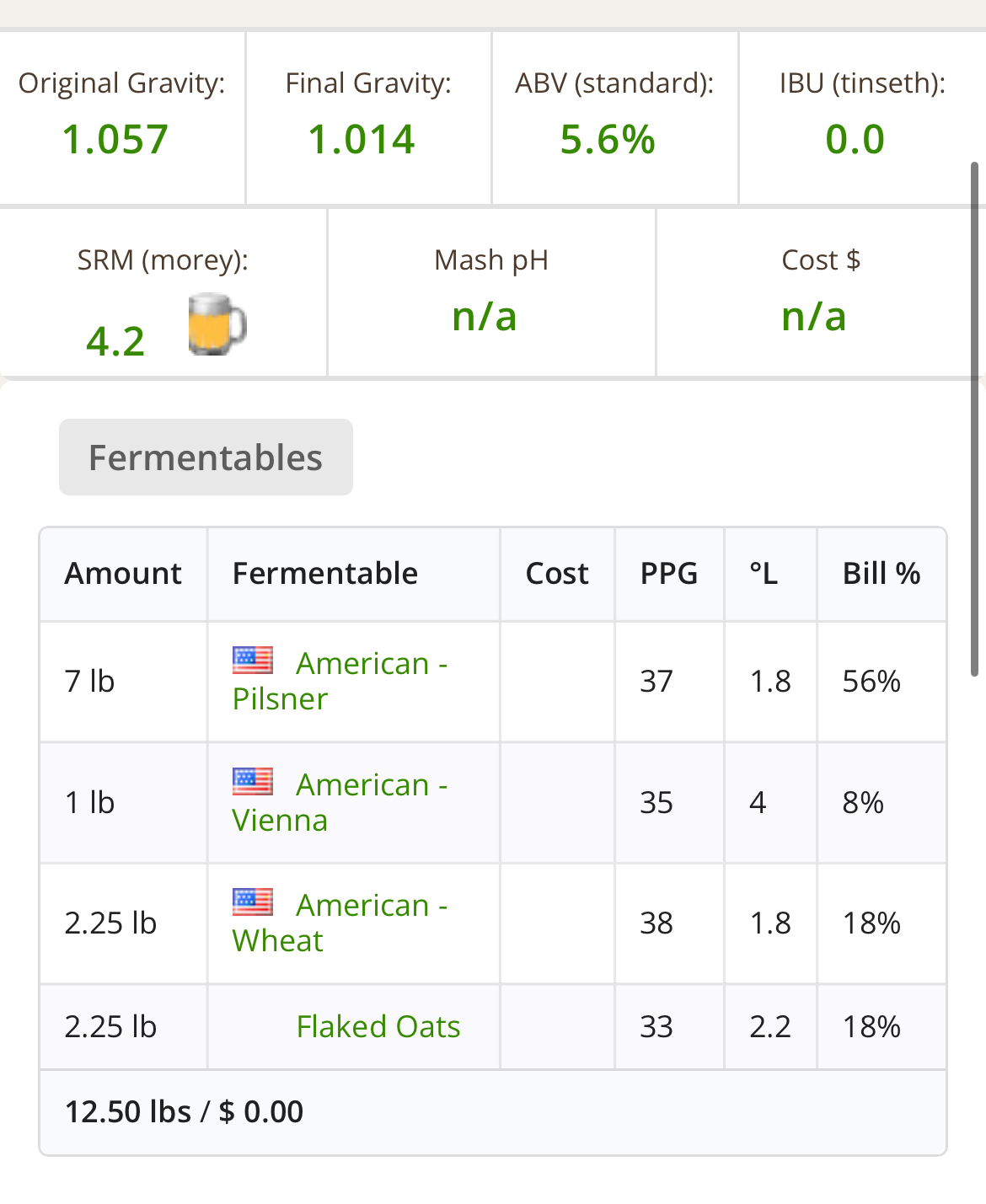
Last edited:
Shenanigans
Well-Known Member
A few years back I went a step further with the low ABV and brewed a so-called micro IPA with about 3%.
I was inspired by a beer I tried when I was back home in Ireland about 5 years ago.
Whiplash Northern lights, which I couldn't believe only had 2.8% alc.
They don't brew it anymore but the description is here and it's what I used to make the attempted clone:
https://brewcrew.ie/products/northern-lights-micro-ipa-2-8-abv-30l-keg-53-pints
They had 16g/l in the dry hop which is just over 2oz per gallon and did a two step dry hop.
I did about 1.5oz per gallon, all at once at the end of the fermentation at room temperature.
I hadn't started soft crashing and dry hopping at cooler temperatures yet.
I did a 75 min mash at 71oC/160F.
In the end I got a little bit higher OG than expected as I didn't have much experience with checking my effeciency at such a low strength.
So I got an OG of 1.037 and an FG of 1.010 with abv. of 3.5% instead of the planned 2.9%
I think the calculated IBUs of 55 from the whirlpool are a bit off, I would say it tasted more like 35 to 45 IBUs.
Nowadays I'm whirlpooling at 80oC instead 85oC.
It was actually a very enjoyable beer in the end if you want something tasty with low alcohol.
I must try it again using some of the new processes I have learned from this thread.
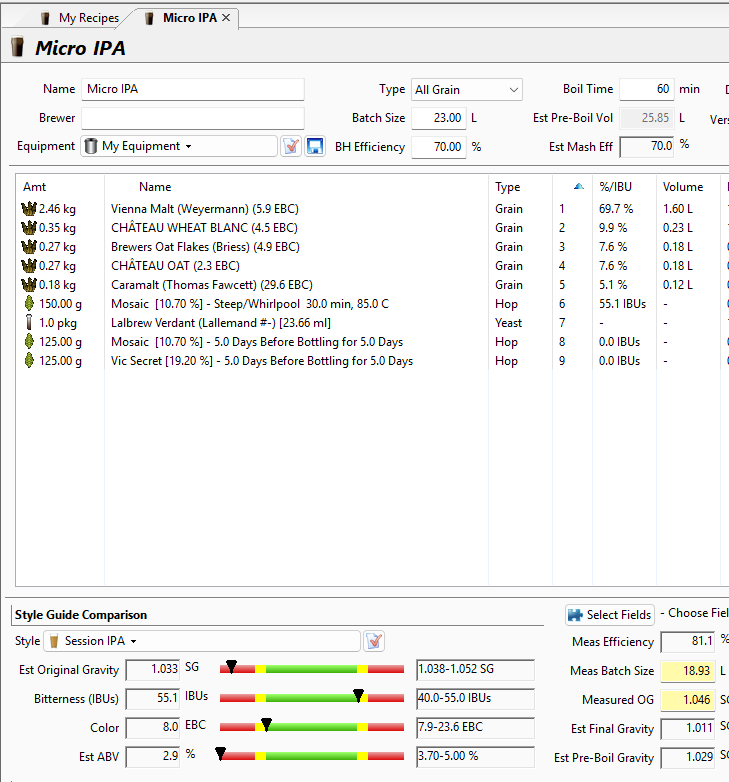
I was inspired by a beer I tried when I was back home in Ireland about 5 years ago.
Whiplash Northern lights, which I couldn't believe only had 2.8% alc.
They don't brew it anymore but the description is here and it's what I used to make the attempted clone:
https://brewcrew.ie/products/northern-lights-micro-ipa-2-8-abv-30l-keg-53-pints
They had 16g/l in the dry hop which is just over 2oz per gallon and did a two step dry hop.
I did about 1.5oz per gallon, all at once at the end of the fermentation at room temperature.
I hadn't started soft crashing and dry hopping at cooler temperatures yet.
I did a 75 min mash at 71oC/160F.
In the end I got a little bit higher OG than expected as I didn't have much experience with checking my effeciency at such a low strength.
So I got an OG of 1.037 and an FG of 1.010 with abv. of 3.5% instead of the planned 2.9%
I think the calculated IBUs of 55 from the whirlpool are a bit off, I would say it tasted more like 35 to 45 IBUs.
Nowadays I'm whirlpooling at 80oC instead 85oC.
It was actually a very enjoyable beer in the end if you want something tasty with low alcohol.
I must try it again using some of the new processes I have learned from this thread.

DuncB
Well-Known Member
I think the perceived lower ibu would fit with the higher abv because your increased alcohol changes the BU:GU ratio.
Shenanigans
Well-Known Member
Good point 0.6% more alcohol can make a significant difference in such a low abv. beer.I think the perceived lower ibu would fit with the higher abv because your increased alcohol changes the BU:GU ratio.
Long story short: I added 8oz of Biscuit malt to my hazy grist, and it gives the final beer a nice deep orange color. The slight toast aroma that is apparent during the boil is overtaken by the hops after DH, but the color is amazing, if you're going for orange vs straw. Along the lines of Julius, which I've heard some people say is oxidized due to the color. (I spoke with Nate about it at length last year. He said he always laughs when people say his beer is oxidized.) Doing another version of it right now.
2 row, White Wheat, Chit and Biscuit (3%). OG 1.070. All Nectaron, baby!!!
2 row, White Wheat, Chit and Biscuit (3%). OG 1.070. All Nectaron, baby!!!
ihavenonickname
Well-Known Member
- Joined
- Sep 20, 2018
- Messages
- 906
- Reaction score
- 6,476
Good to know @wepeeler . I use 2oz of CaraAroma for that orange color, courtesy of @couchsending years ago. No concerns about flavor effects...But it is good to have options ;-).
Similar threads
- Replies
- 4
- Views
- 1K
- Replies
- 2
- Views
- 207

